The Museum Collection: Brewing
Click on the thumbnail pictures to get a bigger view
Brewing beer went from the small-scale of brewhouses at the back of the pub to a large industry in Bradford in the 19th century. Three common brewers -those supplying a number of pubs- were operating here at one time.
Click on the thumbnail pictures for a bigger view.
.
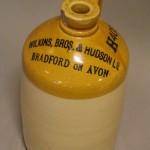 Wilkins Brothers operated a brewery that grew from one behind the Seven Stars in Newtown to become a fairly large malting and brewing operation. The Bristol-made stoneware jar bears the name of Wilkins Brothers and Hudson. The company began to be caught up in the consolidation process in the industry, taking over and merging with other breweries including those in Corsham and Chippenham. In the end Wilkins’ fell victim itself to another company, Usher’s of Trowbridge.
Wilkins Brothers operated a brewery that grew from one behind the Seven Stars in Newtown to become a fairly large malting and brewing operation. The Bristol-made stoneware jar bears the name of Wilkins Brothers and Hudson. The company began to be caught up in the consolidation process in the industry, taking over and merging with other breweries including those in Corsham and Chippenham. In the end Wilkins’ fell victim itself to another company, Usher’s of Trowbridge.
.
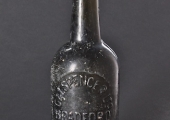 G. & T. Spencer beer bottle . The other big brewery in Bradford was that of George & Thomas Spencer in Whitehead’s Lane. It started at the back of the New Bear in Silver Street and developed up the hillside behind. Like Wilkins’ it was bought by Usher’s and shut down at about the time of the First World War.
G. & T. Spencer beer bottle . The other big brewery in Bradford was that of George & Thomas Spencer in Whitehead’s Lane. It started at the back of the New Bear in Silver Street and developed up the hillside behind. Like Wilkins’ it was bought by Usher’s and shut down at about the time of the First World War.
.
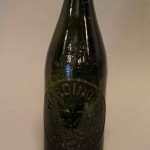 Harding beer bottle. The third brewery, called the Bravon Brewery, was the smallest and was situated in Coppice Hill, behind the King’s Arms pub. Harding built a new off-licence shop on the front, in alien red brick, in Silver Street.
Harding beer bottle. The third brewery, called the Bravon Brewery, was the smallest and was situated in Coppice Hill, behind the King’s Arms pub. Harding built a new off-licence shop on the front, in alien red brick, in Silver Street.
In about 1900 the Bravon Brewery was bought by Simeon Ruddle & Son. The brewery closed in the 1920s so that the family could concentrate on developing their much more famous brewery in Rutland.
.
Ruddle’s beer bottle (left) and screw-in stopper (right).
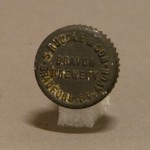 ..
..
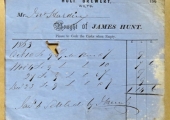 There was a brewery in Holt too. This is a billhead which James Hunt of the Holt Brewery issued to grocery shopkeeper John Harding, also of Holt village, in 1863. Thomas Hunt was a brewer in 1851, when he made his will and he was succeeded by James in the 1860s and John in the 1870s. In 1877 the chimney of the brewery, on Ham Green, blew down.
There was a brewery in Holt too. This is a billhead which James Hunt of the Holt Brewery issued to grocery shopkeeper John Harding, also of Holt village, in 1863. Thomas Hunt was a brewer in 1851, when he made his will and he was succeeded by James in the 1860s and John in the 1870s. In 1877 the chimney of the brewery, on Ham Green, blew down.
.
.
Alongside beers the brewers produced fizzy drinks like lemonade and ginger beer and there were other small-scale manufacturers.
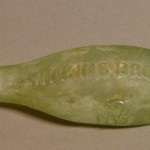 Wilkins Brothers in Newtown produced lemonade and sold it in returnable bottles. The Hamilton bottle from Wilkins is egg-shaped to prevent it from being stood upright; this was because of the problem that the cork would leak the carbon dioxide gas if it dried out.
Wilkins Brothers in Newtown produced lemonade and sold it in returnable bottles. The Hamilton bottle from Wilkins is egg-shaped to prevent it from being stood upright; this was because of the problem that the cork would leak the carbon dioxide gas if it dried out.
.
.
.
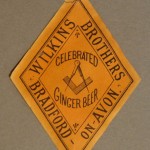 The Museum possesses a number of these diamond-shaped ginger beer labels from the Wilkins brewery.
The Museum possesses a number of these diamond-shaped ginger beer labels from the Wilkins brewery.
The device of compasses and set-square was borrowed from the Freemasons.
.
.
.
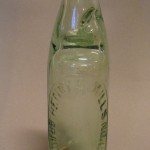 The Codd bottle has the embossed name of Henry Mills, who made mineral waters in Bearfield, Bradford. Hiram Codd patented this method of retaining gas in carbonated drinks in 1862. The idea is that a glass marble trapped in the neck rested against a rubber O-ring in the mouth after the bottle had been filled upside down. The pressure kept it in position even when the bottle was upright. The seal was broken by pushing the marble in and it sank, allowing the drink to be poured. Although there would have been money back on the empty bottle, the glass marble was too attractive to children and many of these bottles were broken. Eventually, these bottles were replaced by those with screw-in stoppers, outside screw caps and crown caps.
The Codd bottle has the embossed name of Henry Mills, who made mineral waters in Bearfield, Bradford. Hiram Codd patented this method of retaining gas in carbonated drinks in 1862. The idea is that a glass marble trapped in the neck rested against a rubber O-ring in the mouth after the bottle had been filled upside down. The pressure kept it in position even when the bottle was upright. The seal was broken by pushing the marble in and it sank, allowing the drink to be poured. Although there would have been money back on the empty bottle, the glass marble was too attractive to children and many of these bottles were broken. Eventually, these bottles were replaced by those with screw-in stoppers, outside screw caps and crown caps.

